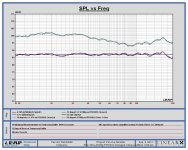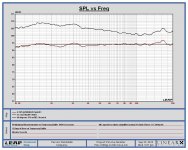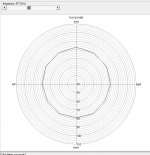The best we can hope to do is playback as accurately as possible what is on the recorded media, without any added distortion. That is if our goal is accurate sound reproduction.
mitchba, I also had been in the music industry (well, I still work when I'm asked). After a few years of spending time occasionally here at DIYAudio for learning purpose, I started thinking that the confusion of the audiophiles comes from above idea; pre-postmodern philosophy. If you would read any of the post-structuralism books by Jacques Derrida or someone else, I believe you would feel that this kind of statement can't be survived in this internet age...
Last edited:
It's a tricky one because it raises unanswerable questions about the recording and mixing equipment and environment.
Hello Augerpro
Looking at the M2 Salon comparison they are both CD designs using the same basic science and design guidelines so I am surprised that there was a clear preference. So what are they hearing? Differences in DI translates to differences in the overall in room frequency response and the Salon won based on that? That would certainly back-up the Tooles position of the importance of frequency response vs preference.
Rob🙂
I still submit their DI indicates they are noticeably different. They are not identical. So it doesn't surprise me they don't sound the same.
Looking at the M2 Salon comparison they are both CD designs using the same basic science and design guidelines so I am surprised that there was a clear preference. So what are they hearing? Differences in DI translates to differences in the overall in room frequency response and the Salon won based on that? That would certainly back-up the Tooles position of the importance of frequency response vs preference.
Rob🙂
Last edited:
Are we really sure that horns and waveguides don't color the sound in subtle ways that are hard to measure? I recently discovered this excellent resource on horns/waveguides and the factors that can affect their sound: Factors Affecting Sonic Quality of Mid & HF Horns & Waveguides
Yeah I remember that glad you posted it but that was many years ago. One of the biggest issues was the periodic ripple in the responses you would see. If you look at either the DSP for the M2 or just a measurement of a compression driver on that horn you don't see that. There is definitely improvement in that respect. I have measurements of the M2 and a JBL S/R waveguide and they look quite smooth in comparison to some of the other horns referenced with the exception being Earls Oblate Spheroid in the original posting. So I am not to sure this is what was heard and the difference between them.
Attachments
I still submit their DI indicates they are noticeably different. They are not identical. So it doesn't surprise me they don't sound the same.
Yup
Floyd Toole said:Early reflections are the dominant room interactions above 500 Hz and this may be the most significant difference between these loudspeakers – directivity. They are quite close, but the Salon2 will energize more far-off-axis early reflections than the M2. For laying down tracks and mixing many engineers discourage room reflections, even use “near field” monitors, although mastering engineers often prefer to hear some “room”.
I suppose one could purposefully select prerecorded music that would favor one type of speaker dispersion over the other.
A proper test might consist of a handful of performers who could play music in a room for seated listeners. There would need to be vocal, percussive and dynamic elements to the music to energize the room acoustically. These performances would have to be recorded live and then mixed in reasonably short period of time (perhaps the listeners break for an extended lunch). These mixes would be made using the speakers under test as monitors and in the same room as the recording was made, so a comparison of two different speakers would yield two different mixes (one from each speaker). These different mixes could be played back on both speakers in a blind listening fashion. The performers would remain to perform the piece live as a reference for the listeners.
Such a test might indicate some interesting results, such as wether there is a preference for a speaker when it is playing back music mixed on it, or whether a particular speaker is preferred regardless.
By direct radiator I assume you mean 180 degree radiator.Can a direct radiatior bring more easily and faster to a random reverberated field?
Per my previous post, I've repeated the measurements. Last time, I was using Augerpro's measurement of an 18Sound XT1086 with a DE250 on a baffle, versus my XT1086 with a BMS 4552 in a loudspeaker with a 4.5" roundover on each side.
This time around, I did the measurement with two XT1086s. One is mounted in a loudspeaker with a 4.5" roundover on each side. One is unbaffled. Both measurements use the same mic (MiniDSP), the same distance (two meters) and the same compression driver (BMS 4552.)
The pattern of the waveguide narrows noticeably right in the worst place, where we want to cross it over, and in the upper midrange where our hearing is very sensitive
If you do an A/B comparison between the two, the differences are subtle:
Hello Patrick,
Thanks for the post. I looked up the manufacturers curves for the CD BMS 4552, It looks like the frequency peek at ~ 18K is the driver and not the horn. I like the ladder / rack. How did you turn the ladder at 11, 22, 33 and 44 degrees or did you move the microphone. Will you show a picture of the 4-1/2 inch round over? I like the XT1086 i am also trying it out with a FaitalPro HF111 driver crossed over at 2K above a 10 inch direct driver.
Thank You DT
By direct radiator I assume you mean 180 degree radiator.
Even more: people like dome tweeters, little cones and little baffles far away the walls. I have no comparison: I never heard a quality horn system.
Maybe it has to do with the idea that horns are thought of for bigger venues than the average home consumer has the space for.... I think as mentioned above JBL has pretty good horn implementations but then again how many bad implementations have been done that people might just be averse to them due to past prejudices. If done right their good especially for farfield listening but if done badly your ruined for life.
I heard the cheap Revels and the expensive Revels back-to-back, and the expensive ones disappear better. One of my theories is that the curved baffle of the more expensive ones helps with the 'disappearing act.' <snip>
When you say "disappearing" better I think you can't disregard the dispersion and tonality. The Ultima2s are extremely directional above 8KHz and the tweeter basically brickwalls there at the 45 degree+ measurements, whereas the Performa3 tweeter has output that gradually peters out to 15KHz before rising again rapidly at 16KHz and above, this is the 60 degree + horizontal measurements.
The Ultima2 design is just much darker with very little high frequency dispersion above the upper mids.
I think about it this way: direct radiators typically fit a half space baffle, and this is arbitrary.. it doesn't fit the room directly. If you want to fill the room (maybe randomly), but efficiently, then this is not the optimum way both because the directivity isn't that way inclined and because it changes with direction.Even more: people like dome tweeters, little cones and little baffles far away the walls. I have no comparison: I never heard a quality horn system.
Headphones (good ones of course) can show you how clean a reflection free environment can be, except that speakers can be so much better 😉.
Last edited:
It could be useful play with a simulator.
A driver radiates in the whole space, wavelenghts long compared to the baffle.
It radiates high frequencies in half space. In beetween it's a mess.
Two images: a box 30cm wide, radiates 400 and 4000 Hz
A driver radiates in the whole space, wavelenghts long compared to the baffle.
It radiates high frequencies in half space. In beetween it's a mess.
Two images: a box 30cm wide, radiates 400 and 4000 Hz
Attachments
Some people do, I don't.Even more: people like dome tweeters, little cones and little baffles far away the walls.
I have.I have no comparison: I never heard a quality horn system.
Touche.I like little cones, but they have to be horn loaded
It is possible to create any directivity at any frequency. It isn't always easy.In beetween it's a mess.
Before you try you should know what is useful for the room to work with. There are a number of ways to approach it, and there is not one way to illuminate a room precisely. Once you figure out what is and isn't audible, and how far you are prepared to go, and what is mandatory (such as tweeter at ear height), then clear options will follow.
OK then, going back to your original question.
What you can do is treat the nearby reflections with absorbing panels. Remember that the tweeter goes narrow at the top end and its reflection may suffer.
You want to fill the reverberant space, and probably reduce the early reflections. One thing you can do is sit close enough that you avoid the ceiling reflection. If you place the speakers well apart the opposite wall reflection is longer. The near wall will be stronger.Can a direct radiatior bring more easily and faster to a random reverberated field?
What you can do is treat the nearby reflections with absorbing panels. Remember that the tweeter goes narrow at the top end and its reflection may suffer.
Hmm, I take it to mean he wants to 'light up' the room as quickly and as much as possible, which at minimum would be the tiny driver/baffle well away and angled from the sound wall and up or down vertically depending on the room acoustics and/or personal preference to create an concert hall bowl type reverberant sound field.
GM
GM
- Home
- Loudspeakers
- Multi-Way
- The Preference for Direct Radiators




